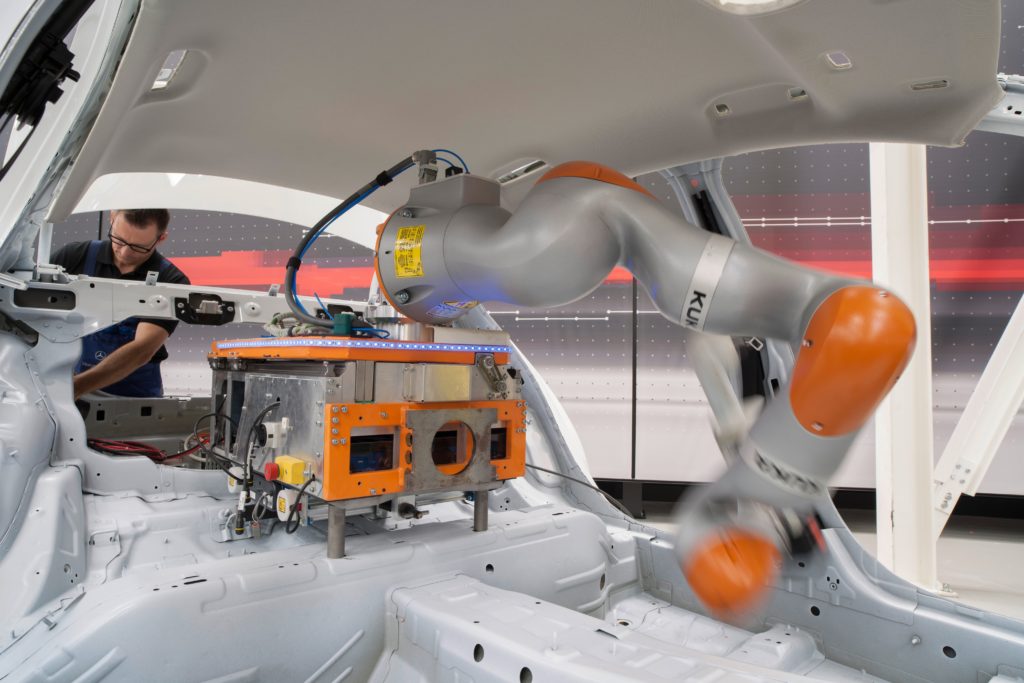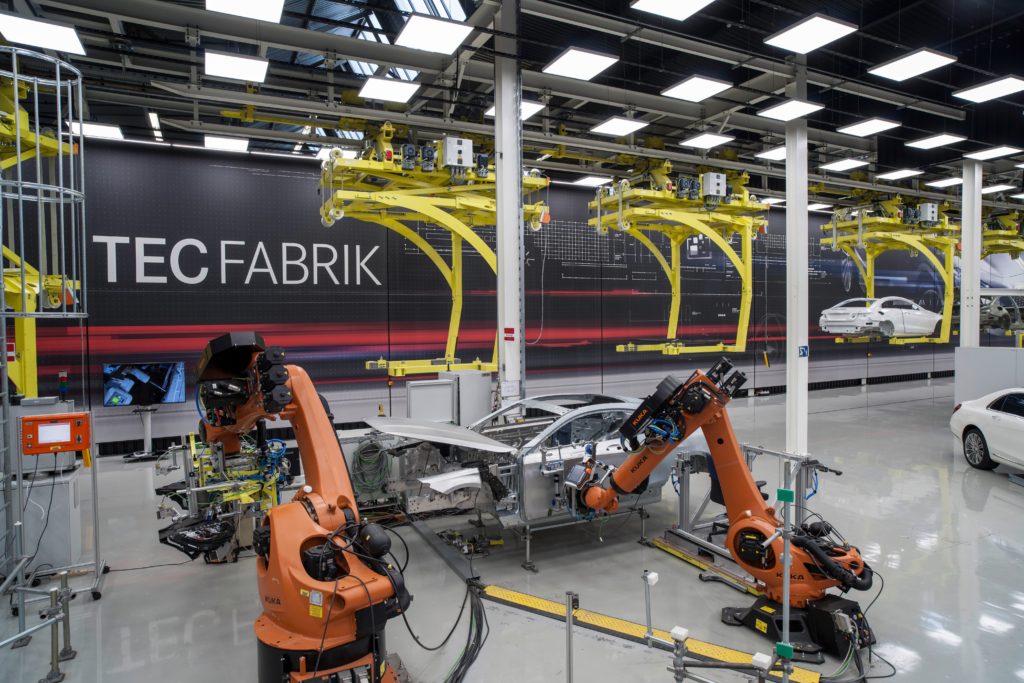Daimler sets its sights on vision of smart factory
At Daimler, the “smart factory” is the centrepiece of the digitalisation of the entire company. In the smart factory, the products, machines and the entire environment are networked with each other and connected to the internet. Integration of the real world into a functional, digital world enables a so-called “digital twin” to be created, which allows the real-time representation of processes, systems and entire production shops.
“Digitalisation enables us to make our products more individual, and production more efficient and flexible. The challenge is to plan for the long term while remaining able to respond rapidly to customer wishes and market fluctuations,” says Markus Schäfer, executive board member Mercedes-Benz cars production and supply chain management.
“The working environment in the automobile industry is facing major and very rapid changes,” says Michael Brecht, chairman of the Daimler works council. “We want to be actively involved in shaping these changes. One key to this is undoubtedly the systematic, far-sighted training of the current and future workforce.”
Increasing networking and systems intelligence will allow more flexibility in all processes. Future systems will be able to plan ahead, optimise themselves, communicate better with people and provide more certainty. Another decisive aspect in the factory of the future is the interface between man and machine. Fenceless production will be one of the far-reaching changes in this.
Mercedes-Benz is following five major objectives with the smart factory:
- Greater flexibility: The smart factory allows production to respond even faster to global market fluctuations and changing, even more individual customer demand. Digital production also makes it easier to produce increasingly complex products.
- Greater efficiency: Efficient use of resources such as energy, buildings or material stocks is a decisive competitive factor; a completely digital process chain also means constant inventory control: components can be identified at any time and anywhere. Production facilities can be controlled from anywhere.
- Greater speed: Flexible production processes, simplified modification of existing production facilities and the installation of new facilities allow simpler, more efficient manufacturing processes. This in turn allows shorter innovation cycles, and product innovations can be transferred to more model series in a shorter time (time-to-market).
- Attractive working environment: Active interaction between man and machine, also using new operating interfaces, will change the working environment in many areas, for example in training and ergonomics. Taking demographic changes into account, this opens up new perspectives when creating new working and lifestyle models.
- Smart logistics: from vehicle configuration and ordering by the customer to the definition of required parts and their procurement, and then to production and delivery. To put this in visionary terms: “Once ordered, a vehicle looks for its production location and machine by itself.”
To achieve these goals, extensive changes will not only be required at production sites. The central approach is to achieve a completely digital process chain. On the product side, for example, the conditions for digital production are to a great extent already in place with digital prototyping and the digital development process: vehicle data are available in great detail.
360° networking: All machines speak the same language
Another precondition for a production system that is completely networked and flexible is that all the elements in the system speak the same language. Mercedes-Benz ensures this by comprehensive, worldwide use of “Integra” control software: from sensor level at individual machines right up to production control, and also in its cooperation with all suppliers and system partners.
Mercedes-Benz is already able now to digitally simulate the production process from the press plant to final assembly, and therefore to master the complexity of modern automobiles and their manufacture: for assembly alone, around 4000 individual processes are examined for technical feasibility long before series production commences. This also includes feed-back to vehicle engineering verifying suitability for assembly and availability of installation space, material flows and workplace ergonomics.
The decisive next step, also after production has commenced, is to continue digitally documenting the real factory: a virtual representation of the real factory is maintained in real time as a “digital twin”. This includes for example regular, automated capture of the actual situation in the factory, possibly involving the use of drones in future to fly over and scan the production lines.
Big data: self-learning and self-optimising production system
All processes already generate large amounts of data and this is set to increase even further in future. Experts refer to this as “Big Data”. In future, these product and production data will be evaluated more systematically and used more rigorously. The end result will be more efficient control loops and focussed, more intelligent decisions by the responsible personnel.
Information measured and gathered locally, such as the quality of surfaces, will then no longer be evaluated manually but rather made usable by intelligent analytical processes, and employed to control machinery, for rapid identification of causes when faults develop, or to plan maintenance and repair work. In ongoing production, digital reference models can already tell why certain machines/processes deviate from set parameters. Digital process data are used to predict when processes will deviate from standards, and pre-emptive maintenance stabilises processes and quality.
In cylinder head production, for example, the capturing and evaluation of 600 parameters that influence quality has significantly reduced the rejection rate by a factor of 4. The effect has been even more considerable during production start-ups: The time taken for the production process to run smoothly has been substantially reduced.
In the production of dual-clutch transmissions, feeding back production data and service data from the field has led to quality improvements and reduced costs. Predictive analysis also gives early indications for the start-up of comparable components.
Flexible production: New technology creates flexibility
Today, many production processes are characterised by complex full automation with the rigid installation of machines and robots. Changes are expensive and require a great deal of time and space. For safety reasons alone, man and machine are strictly separated by extensive protective fencing and safety features.
Future generations of robots will allow a greater degree of cooperation with people: fenceless systems are much easier to change over, processes become leaner and the capital employed is used much more efficiently.
In “Robot Farming”, an employee will operate one or more robots depending on the required volume and production steps, using them flexibly at different workstations and even working together with them in the same area without protective fencing.
More flexibility is also required in handling technology. Today, transport and conveyor systems are fixed installations with rigid sequences. Volume flexibility is limited and changes require expensive and time-consuming conversion work. Intelligently controlled, driverless transport systems (DTS) provide optimum capital employment, thanks to scalability and complete freedom of configuration. This also allows flexible buffering in the production process.
Plant logistics are also becoming leaner. Driverless, fully automatic pickers deliver exactly the parts required to the personnel at a workstation, in the form of a so-called carset for the current assembly job. The result is considerably improved workplace ergonomics, less walking distance, higher quality, direct material access, more space at the production line and lower risk of accidents thanks to the absence of fork-lift trucks.
More flexibility and less capital commitment also come from “jigless welding”, where complex jig technology is replaced by cooperation between two robots: These hold the components to be joined and bring them into the best position for the welding process. One example of this in series production is seat manufacture for the Mercedes-Benz Sprinter.

Future-proof: integration of new technologies
The flexibility of the smart factory also means rapidly and successfully integrating future technological developments into the production process. Examples include:
- 3D printing/Additive Manufacturing: Use in rapid prototyping (for example, sand-casting moulds for engines), protective covers (for example, for tooling in Human-Robot cooperation), tools (for example, gripping elements)
- Human Augmentation/Mobile devices in production: New ways of calibrating head-up displays (from mid-2016), use of tablets for controlling robots inside vehicles (“InCarRob”) via Wi-Fi (worker instructs robots in headliner assembly)
- Machine learning/machines assist their users: The path to be followed by lightweight robots can be generated by “demonstration”, that is the worker leads the robots and the machine learns the path
- Production data cloud: Worldwide availability of production data
- Gesture control: Machines “understand” what people want from them
Step-by-step: en route to the digital factory
Stage by stage, the smart factory concept is being realised in the global production network of Mercedes-Benz. The first two stages have already been clearly defined and substantially achieved:
- Mercedes-Benz now has global component standards, a standardised systems architecture and standardised automation, regulation and control technology.
- Wherever investments are made, globally standardised technology modules are used in robotics and production processes.
For example, as the lead plant for compact models, Rastatt is able to access production data from all the other plants in the worldwide production network, for example Kecskemét, and would even be able to reprogram the robots in operation there.
In addition, every vehicle body manufactured in Rastatt bears an RFID chip (Radio Frequency Identification). All the vehicle details are stored on this digital label. Transponders are used to access the data and add new data. It is therefore possible to see at any time how far production has progressed, and what is still to be done. The data are used to control 1500 automatic machines.
The next steps on the way to the production of the future are globally applicable equipment modules suited to product modules, and standardised working strategies. Before the end of the decade, this specific vision of the smart factory will come together in the form of a reference factory designed completely for the methods and processes described above.
Scientific backup on the way to the digital factory is provided by the Arena 2036 project (Active Research Environment for the Next Generation of Automobiles): This is a research campus where Daimler conducts research into the future of production and lightweight design with partners from the scientific community and industry. The project will continue to the year 2036, when the automobile celebrates its 150th birthday.


